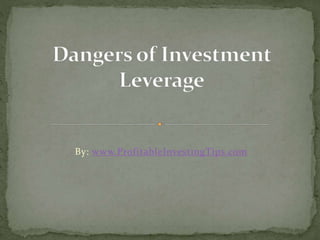Dangers of Investment Leverage
- 2. There are ways to magnify your investment gains in the stock, currency, and futures markets. This approach has to do with creating leverage for your investing or trading capital. The rewards of using investment leverage can be impressive. However, the dangers of investment leverage are such that one needs to proceed with caution. Success comes from using leverage in very carefully chosen situations. Investment disaster comes from letting greed drive your investment decisions.
- 4. What Is Investment Leverage?
- 5. There are three common leveraged investing strategies. One is borrowing from a broker and trading on margin. Another is by trading options. A third is when one invests in a security that uses leverage such as a leverage ETF. All these approaches can be profitable in the right hands. The basic issue is that with the potential for multiplied gains there comes the risk of multiplied loss. A good rule of thumb when using investment leverage is to never put at risk more than you can afford to lose.
- 6. Trading on Margin for Leverage
- 7. A common approach to trading stocks, futures, or currencies is to put money into a margin account with a broker. That account acts as collateral. The trader can then borrow from the broker in order to buy stocks or “sell short.” The trader pays interest on the loan. When this works out well the trader is essentially using someone else’s money and thus leveraging their own trading capital.
- 8. If the trade goes badly, money is owed by the margin account. If the amount of loss in a trade exceeds the size of the margin account the trader receives a “margin call” telling them that they need to put more money into their margin account. If they cannot do that the broker takes over the trade and takes whatever assets are remaining.
- 9. Trading Options for Leverage
- 10. In the options market one buys or sells call or put contracts. Calls provide the buyer with the right to buy a stock at the contract price no matter how high the price subsequently climbs. Puts confer the right to sell at the contract price no matter how low the market price falls. Those who sell these contracts are obliged to sell in the case of a call and buy in the case of a put. Thus, the seller is paid a premium for taking on the risk and the buyer pays a premium for an opportunity.
- 11. Risks When Buying Calls or Puts
- 12. When a trader buys a call on a stock they are paying much less than if they had purchased the same amount of stock. If the price goes up in the case of a call or down in the case of a put, they can exit the contract with a profit similar to if they had bought and then sold or sold and then repurchased.
- 13. This is the leverage part. For a lot less money the trader can get roughly the same profit. The risk in this case is that the stock will not go up or down in price as anticipated. However, the risk is limited to the cost of the option contract.
- 15. Risks When Selling Calls or Puts
- 16. Sellers of options get money up front. This is the sum total of their profit. They retain that profit if the stock in question does not move up or down, contrary to their expectations. The leverage part is that they do not need to pay any money to own the stock to start this trade. They are taking on risk.
- 17. Thus, the seller of an option contract can gain a nice premium while not investing any money! The risk is that the stock in question not only goes up or down contrary to their expectations. It goes up or down dramatically which can create monumental losses. There have been cases where investment banks have gone out of business due to the actions of a single trader selling ill-advised calls or puts.
- 18. Leveraged ETFs
- 19. In the cases of trading on margin and options trading the trader or investor has their fate in their own hands. In the case of leveraged ETFs an investor is trusting someone else. These investments work like margin accounts where profit may be two, three, or more times normal. And losses follow the same multiple. These vehicles are generally designed to create profits within a trading day.
- 20. This is sort of like investing in a day trader. These investment vehicles do not perform over time the same as the underlying stock or index that they are tracking. These are very risky investments best left to those with the capital to absorb big losses and the time and expertise to track their performance every moment of every day!
- 21. Don’t Invest If You Don’t Understand
- 22. We frequently mention that successful long term investors like Warren Buffett never invest in a company unless they fully understand what they do to make money. And they never invest until they are certain that the company’s business plan will continue to generate profits well into the future. Using this sort of conservative investment philosophy it could be possible to increase one’s profits by using leverage.
- 23. Sadly, far too many novice investors fall prey to greed and use leverage with investing and trading vehicles that they do not understand. They employ this approach to stocks, currency pairs, or commodity futures where they do not have the necessary knowledge or skills. The bottom line of this little lesson is this. Don’t invest if you don’t understand exactly what you are dealing with and what you are doing in any investment and this includes using leverage.
- 24. For more insights and useful information about investments and investing, visit www.ProfitableInvestingTips.com.























